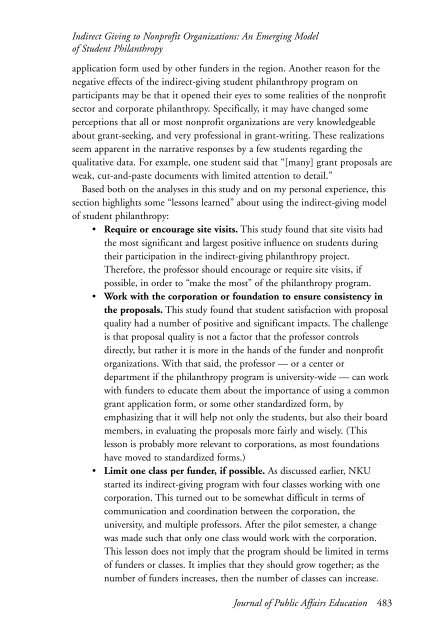JOURNAL OF PUBLIC AFFAIRS EDUCATION - National ...
JOURNAL OF PUBLIC AFFAIRS EDUCATION - National ...
JOURNAL OF PUBLIC AFFAIRS EDUCATION - National ...
Create successful ePaper yourself
Turn your PDF publications into a flip-book with our unique Google optimized e-Paper software.
Indirect Giving to Nonprofit Organizations: An Emerging Model<br />
of Student Philanthropy<br />
application form used by other funders in the region. Another reason for the<br />
negative effects of the indirect-giving student philanthropy program on<br />
participants may be that it opened their eyes to some realities of the nonprofit<br />
sector and corporate philanthropy. Specifically, it may have changed some<br />
perceptions that all or most nonprofit organizations are very knowledgeable<br />
about grant-seeking, and very professional in grant-writing. These realizations<br />
seem apparent in the narrative responses by a few students regarding the<br />
qualitative data. For example, one student said that “[many] grant proposals are<br />
weak, cut-and-paste documents with limited attention to detail.”<br />
Based both on the analyses in this study and on my personal experience, this<br />
section highlights some “lessons learned” about using the indirect-giving model<br />
of student philanthropy:<br />
• Require or encourage site visits. This study found that site visits had<br />
the most significant and largest positive influence on students during<br />
their participation in the indirect-giving philanthropy project.<br />
Therefore, the professor should encourage or require site visits, if<br />
possible, in order to “make the most” of the philanthropy program.<br />
• Work with the corporation or foundation to ensure consistency in<br />
the proposals. This study found that student satisfaction with proposal<br />
quality had a number of positive and significant impacts. The challenge<br />
is that proposal quality is not a factor that the professor controls<br />
directly, but rather it is more in the hands of the funder and nonprofit<br />
organizations. With that said, the professor — or a center or<br />
department if the philanthropy program is university-wide — can work<br />
with funders to educate them about the importance of using a common<br />
grant application form, or some other standardized form, by<br />
emphasizing that it will help not only the students, but also their board<br />
members, in evaluating the proposals more fairly and wisely. (This<br />
lesson is probably more relevant to corporations, as most foundations<br />
have moved to standardized forms.)<br />
• Limit one class per funder, if possible. As discussed earlier, NKU<br />
started its indirect-giving program with four classes working with one<br />
corporation. This turned out to be somewhat difficult in terms of<br />
communication and coordination between the corporation, the<br />
university, and multiple professors. After the pilot semester, a change<br />
was made such that only one class would work with the corporation.<br />
This lesson does not imply that the program should be limited in terms<br />
of funders or classes. It implies that they should grow together; as the<br />
number of funders increases, then the number of classes can increase.<br />
Journal of Public Affairs Education 483

















